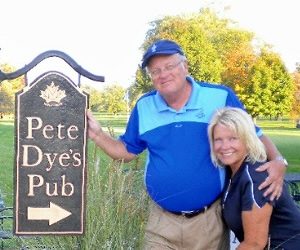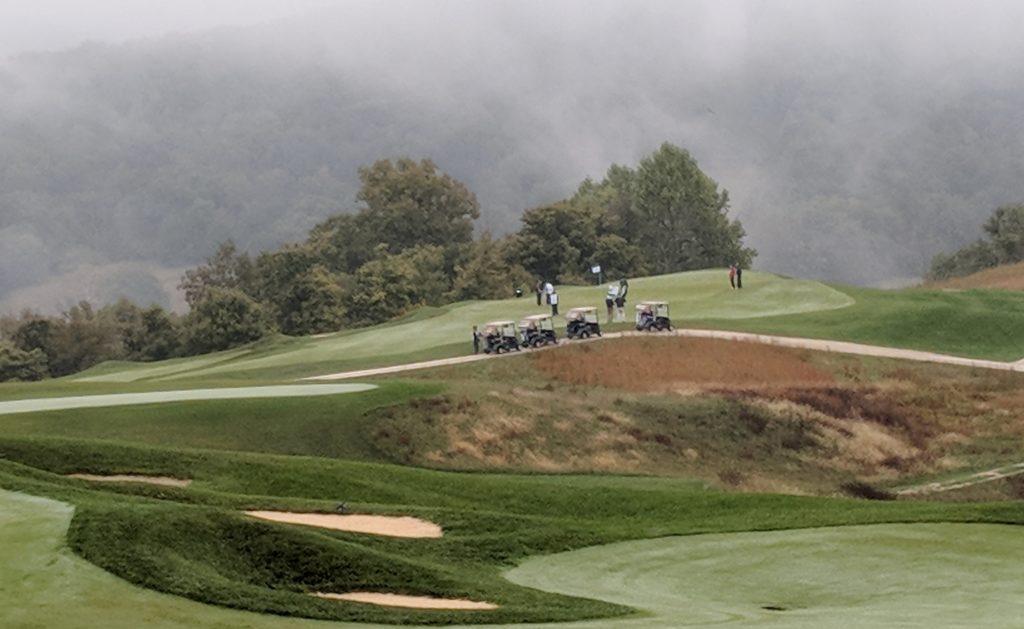In the early 1980s the Chicago amateur ranks were dominated by a fabulous foursome, David Ogrin, Gary Pinns, Gary Hallberg and Jerry Vidovic. Toss in Lance Ten Broeck and Roy Biancalana, who were slightly younger than that group, and you had what I consider the Golden Years of Chicago amateur golf.
Ogrin, Hallberg and Ten Broeck were winners on the PGA Tour. Pinns and Biancalana played on that circuit and Vidovic won a national title – the U.S. Amateur Public Links. It’ll be tough to top that group.
The last few years, however, produced a Fabulous Foursome, too, in Doug Ghim, Nick Hardy, Patrick Flavin and Tee-K Kelly. You could also mix in the slightly older Vince India and Brad Hopfinger, too. Those two are among the select nine players with wins in both the Illinois State Amateur and Illinois Open and are now past the rookie stage on the Web.com Tour.
Ghim, Hardy, Flavin and Kelly all had their moments as amateurs and are new to the pro game. It’ll be interesting to see how their careers play out, but – suffice it to say for now – they’ll be missed around the local tournament scene this season.
Who was the best as an amateur? That’s hard to say. Ghim ventured to the University of Texas and basically limited his Chicago play to the Western Amateur. Kelly won the Illinois State Amateur twice and was runner-up another time.
Hardy had the best single tournament performance with his record 28-under-par over 54 holes to capture the 2016 Illinois State Amateur and he was always a factor in the Western Amateur and Illinois Open. Flavin had the best single season when – in 2017 — he became the first player in 37 years to win both the Illinois State Amateur and Illinois Open in the same year.
So, what happens now?
Ghim moved to Las Vegas and finished a solid third in the final stage of Web.com Tour qualifying. India, the reigning Illinois Open champion, regained his Web.com Tour card with a 12th place finish in his return to Q-School. They’ll be easy to follow, since they have a tour with almost weekly tournaments to play in. Both made the cut in the first one of 2019, in the Bahamas.
Kelly already won on the PGA’s Latinoamerica circuit – a whopping seven-shot victory in 2017 — and will be able to compete there again. His challenge will be to elevate his game to another level, and another tour.
For good friends Hardy and Flavin, it’s a little different. They established residences in Scottsdale, Ariz., during winter that are 10 minutes apart. In April, or whenever the Chicago weather permits it, they’ll return to the area and practice at the Merit Club in Libertyville. Finding tournaments might be a challenge, as neither has status on any tour yet.
Flavin survived only the pre-qualifying stage of Web.com Tour qualifying. He had better luck after moving to Scottsdale in November, finishing seventh and second in two mini-tour events with a missed cut in an event in Mexico in between.
“My game feels good, and I love being out here,’’ said Flavin, who is living with a college teammate from Miami of Ohio until his return to Chicago.
Flavin didn’t get the big tournament exposure that Hardy did as a member of the University of Illinois’ powerhouse teams, so he’s taking a different approach to his first season as a pro.
“I’ll go into the Latinoamerica Q-School, then the Canadian Tour Q-School,’’ he said. “That’ll give me the most kicks of the can, and if I finish well on the money lists I can move up to the Web.com. Playing a schedule like that really suits my game.“
The Latinoamerica Q-School will be a special experience. The competition will be held in Brazil, on the same course that hosted the last Olympics golf tournament.
Hardy, who made the cut in two U.S. Opens as an amateur and earned paychecks on both the PGA and Web.com circuits last year after getting into events on sponsor’s exemptions, did enter the Monday qualifier for the Waste Management Phoenix Open on the PGA Tour. Other than that he wasn’t sure where he’d be playing immediately after returning to the U.S. following a winter visit to Australia.
“My schedule is tough to plan,’’ he said. “I have to earn my way into tournaments. I’ll play in a lot of Monday qualifiers and try to earn my status that way.’’
Hardy made it through the first stage of Web.com Tour qualifying but came up two strokes short in the second stage. Players who reach the third and final stage have at least limited status on the circuit.
“Q-School was a great learning experience, though I didn’t play my best,’’ said Hardy, “Now I’ll take what I learned as an amateur and at Illinois. I feel great about my game.’’
On the women’s front Chicago will have a changing of the guard on the Ladies PGA Tour. For nearly three decades the only Chicago player on the premier women’s circuit was Nicole Jeray. With Jeray, 48, taking a teaching job at Mistwood in Romeoville, the lone Chicago representative on the LPGA circuit will be Winnetka’s Elizabeth Szokol, and she has the credentials to do quite well.
Szokol, who will be an LPGA rookie in 2019, earned her place on the circuit by finishing fourth on the Symetra Tour money list in 2018. Her second season on the LPGA’s developmental tour was a solid one after she was sidelined for eight weeks by knee surgery in January.
She won the IOA Invitational in May – her second start of the season – and tied for third in the season-ending Symetra Tour Championship. In between Szokol had four more top-10 finishes en route to earning $76,612 in her 20 tournament appearances. She’s expected to make her LPGA debut overseas in February. The LPGA has four tournaments – in Australia, Thailand and Singapore – before holding its first event in the U.S. at Phoenix in March.
Jeray, meanwhile, isn’t done competing. She earned a place in one of the LPGA majors — the KPMG Women’s PGA Championship — with a strong showing in last year’s LPGA Teaching & Club Professionals National Championship and is especially focused on winning the Illinois Women’s Open for the third time on the course where she now works.
Already the IWO champion in 1998 and 2003, she hopes to become the first player to win the tournament in three decades.
 It was back in 2010 that then Indiana governor Mitch Daniels triggered the creation of the Pete Dye Golf Trail to stimulate tourism in the Hoosier State.
It was back in 2010 that then Indiana governor Mitch Daniels triggered the creation of the Pete Dye Golf Trail to stimulate tourism in the Hoosier State.













